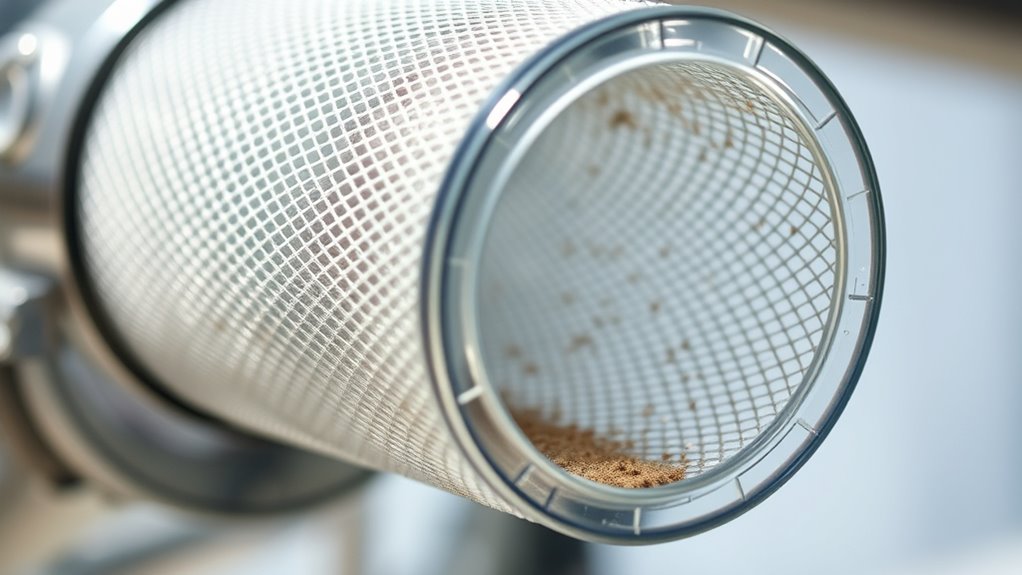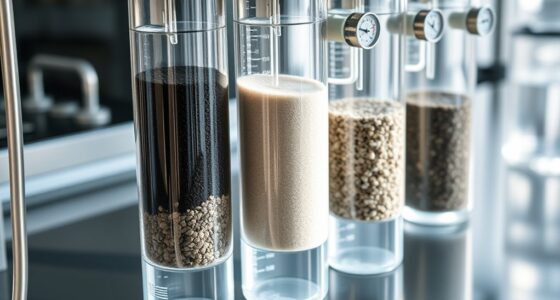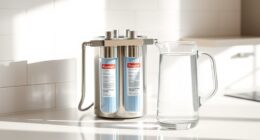Pre-filters are small, initial filters that trap larger particles like dust, pet hair, and debris before they reach your main filters. By catching these larger contaminants first, pre-filters help prevent clogging and extend the life of your primary filters. Proper maintenance and timely replacement guarantee your system runs efficiently and reduces overall costs. Keeping pre-filters clean also improves indoor air quality. Stay with us to discover more tips on maintaining your filters effectively.
Key Takeaways
- Pre-filters capture large particles, preventing clogging of main filters and extending their lifespan.
- Regular maintenance of pre-filters ensures efficient system operation and reduces filter replacement frequency.
- Proper pre-filter care minimizes system strain, lowering energy consumption and operational costs.
- Pre-filters protect the entire filtration system from dirt, dust, pet hair, and debris buildup.
- Environmental factors like dust and pet presence increase the importance of routine pre-filter checks and cleaning.

Pre-filters play a essential role in extending the life of your main filters by capturing larger particles before they reach the more delicate filtration stages. When you consider your air quality, it’s easy to overlook how crucial these initial filters are in maintaining a clean, healthy environment. By trapping dirt, dust, pet hair, and other sizable debris upfront, pre-filters prevent your primary filters from becoming clogged too quickly. This not only enhances their efficiency but also reduces the frequency of replacements, saving you money over time. Proper maintenance tips for pre-filters are simple but necessary; regularly inspecting and cleaning them ensures they continue to perform effectively. Depending on your air quality and usage, you might need to clean or replace your pre-filters every few months. Keeping an eye on them prevents the buildup of pollutants that can degrade overall air quality and strain your main filters. Additionally, understanding the types of filters used in your system can help you select the most suitable pre-filter options for your environment.
When your pre-filters are clean, your entire filtration system works more efficiently. This means your HVAC system or air purifier doesn’t have to work as hard to maintain ideal air quality. As a result, energy consumption drops, and you prolong the lifespan of your main filters. Neglecting pre-filter maintenance, on the other hand, can lead to rapid clogging, which forces your system to operate less effectively, leading to higher energy bills and more frequent filter replacements. To maximize their benefits, you should follow manufacturer guidelines on cleaning or replacing pre-filters. Usually, this involves vacuuming or washing reusable pre-filters and swapping out disposable ones. Ensuring these steps are part of your routine can dramatically improve your indoor air standards while reducing ongoing maintenance costs. Proper care of air filtration components is essential for maintaining healthy indoor environments.
Additionally, paying attention to the environment where your filters operate can help you determine how often you need to check on your pre-filters. If you live in an area with high pollution levels, dusty conditions, or if you have pets, your pre-filters will likely need more frequent attention. Regular maintenance not only extends the life of your main filters but also contributes to healthier indoor air quality. When you keep your pre-filters clean, you prevent the buildup of allergens and other airborne pollutants, which is especially important if anyone in your household suffers from allergies or respiratory issues. Ultimately, taking care of your pre-filters is a simple yet effective way to guarantee your entire filtration system runs smoothly, saving you money and improving the air you breathe every day.
Frequently Asked Questions
Can Pre-Filters Remove All Types of Contaminants?
Pre-filters can’t remove all types of contaminants because water impurity varies widely. They mainly target larger particles, debris, and sediment, which helps improve filtration efficiency. However, tiny contaminants like bacteria, viruses, or chemicals often need additional filters. Using a pre-filter extends the life of your main filter by catching the bigger impurities first, but for complete purification, consider specialized filters that target specific water impurities.
How Often Should Pre-Filters Be Replaced?
You should replace your pre-filters based on your maintenance schedule or when replacement indicators signal it’s time. Typically, check them every 1 to 3 months, but this depends on usage and water quality. Regular inspections help you catch clogs or sediment buildup early, preventing damage to your main filter and extending its lifespan. Stay attentive to indicators and follow manufacturer recommendations for peak performance.
Do Pre-Filters Affect Overall System Performance?
Ever wondered if pre-filters impact your system’s performance? They actually enhance system efficiency by removing larger contaminants before they reach main filters, preventing clogging and reducing strain. This means your system runs smoother and lasts longer. By catching debris early, pre-filters guarantee ideal contaminant removal, which maintains high performance levels. So, yes, they positively influence overall system performance, making maintenance easier and extending equipment lifespan.
Are Pre-Filters Compatible With All Filtration Systems?
Pre-filters aren’t compatible with all filtration systems, as their filter material and installation compatibility vary. You’ll need to check your system’s specifications and verify the pre-filter’s design matches. Some systems may require specific sizes or types of pre-filters, so always confirm compatibility before installation. When properly matched, pre-filters can effectively extend filter life and improve overall system performance.
What Are the Signs Indicating a Pre-Filter Needs Changing?
You’ll know your pre-filter needs changing when you notice indicator signs like reduced water flow, increased pressure, or visible dirt buildup. These signs suggest the pre filter lifespan is nearing its end and its effectiveness is declining. Regularly checking for these indicators helps you replace the pre-filter promptly, ensuring peak filtration and preventing strain on your main filter. Staying attentive extends filter life and maintains clean, healthy water.
Conclusion
By using pre-filters, you’re giving your main filters a shield, much like a guardian protecting a treasure. This simple step keeps dirt and debris at bay, preventing clogs and extending filter life. Think of it as planting a barrier that preserves the health of your entire filtration system. With a pre-filter in place, you’ll enjoy cleaner air or water, save money, and reduce maintenance, making your system run smoother and longer—like a well-oiled machine in motion.









